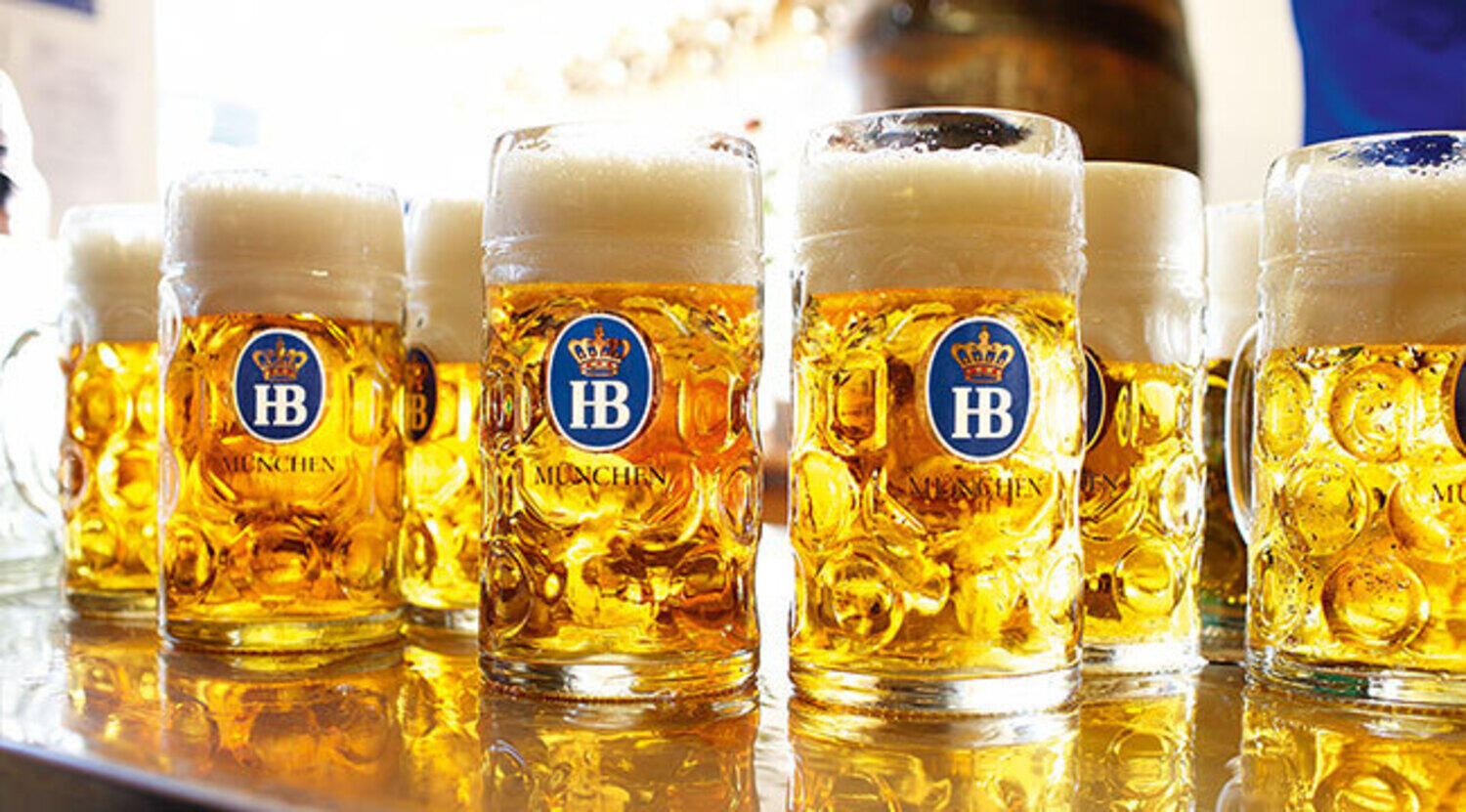Our classic Bavarian brews are imported directly from the brewery in Munich, Germany. All are brewed according to the 500-year-old Purity Law of 1516 for pure flavor in every sip.
The best beer you can find in Las Vegas is at the Hofbrauhaus Las Vegas. You are asking why? Because everyone knows that the best beer in the world is German beer. Where else can you enjoy an ice-cold German beer than at the Hofbrauhaus?
Is it possible for a beer to have a personality? Let us ask you this: Do fish swim? Do babies crawl? Do dirndls look awesome? You see where we are going with this, right? For centuries Hofbrauhaus has been a symbol of Munich’s hospitality. Beer lovers from all over the world come to experience famous brews in a one-of-a-kind atmosphere. But one beer embodies the spirit of Bavaria more than any other.
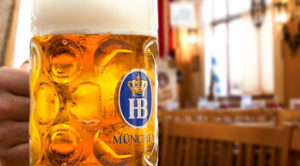
Hofbrau Original!
Boasting a refreshing flavor, fine hops aroma, and around 5.1% abv, this bottom-fermented brew is as well balanced as it is delicious. It has true character. We are proud to export this original brew to the four corners of the globe. We can’t keep something this good to ourselves!
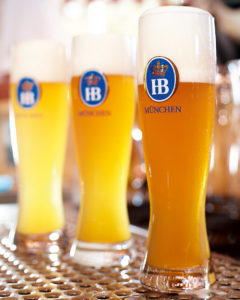
Before there was Boardwalk and Park Place, a monopoly existed in Bavaria. Back in 1602 Munich’s first Hefe Weizen, Weissbier (aka Weizenbier), could only be brewed by ducal privilege. Hofbrauhaus relished this right for more than 200 years, thus creating a monopoly on Weissbier in Bavaria. But even without a monopoly, Muenchner Weisse is pretty darn special. We can’t think of anything more pleasurable than a thirst-quenching brew that tingles all the way down. Except for maybe 5.1% abv. and a refreshing and fruity taste that can only come from being brewed by ancient tradition.
Hofbrau Hefe Weizen – Isn’t it time you tried this game-changing brew if you haven’t yet?
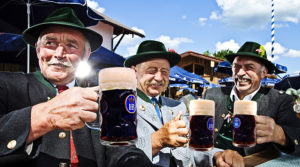
Did you know dark beer existed in Bavaria long before its light counterpart? In fact, it was the first type to be brewed at the original Hofbrauhaus in Munich! Here is something else you may not know: when people talk about dark beer, chances are they mean a Munich-style brew. This archetypal Bavarian beer still reigns as one of our most well-rounded flavors. Whether you are celebrating the start of the weekend or a wedding anniversary, this spicy, bold brew featuring 5.5% abv. is perfect for every occasion. Hofbrau Dunkel!
Not convinced yet, that you will drink the best Beer in Las Vegas at our Haus?
Our seasonal brews are available during limited times throughout the year and are imported directly from the brewery in Munich, Germany. All are brewed according to the 500-year-old Purity Law of 1516 for pure flavor in every sip.
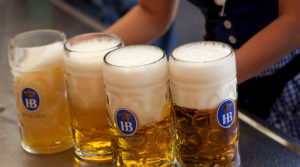
Every year over 250,000 people fill the Hofbrau tent in Munich, Germany, in search of one thing; Oktoberfestbier! But this isn’t just any beer. This is a beverage brewed from pure water, the best quality malt, and perfect hops. Brewed exclusively by Hofbrau Muenchen, Oktoberfestbier is a full-bodied lager known for its clean, crisp edge and ability to get any party started. Here is our favorite part; it is 6.3% abv. Can’t make it to Munich for Oktoberfest? No worries. You can still enjoy the flavor behind the celebration. We import the Oktoberfestbier from the same batches that are made for their infamous Oktoberfest tent to our Haus.
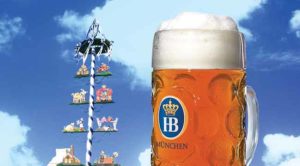
Did you know spring’s signature brew is also one of Munich’s oldest beers? Yep, this oldie but goodie was created in 1614 due to the people of Munich’s demand for a newer and stronger beer. Brew Master Elias Pichler was the man who rose to the challenge.
Since the beer would have to travel long distances, Pichler turned to the Einbeck brewing method. This called for heating the beer to an extremely high temperature which enabled it to ferment longer. After much experimenting, Pichler finally succeeded in creating a flavor as strong as it was refreshing. The people were pleased.
Today Maibock is still made using Pichler’s 400-year-old formula and is recognized for its pale copper hue and malty flavor with hints of caramel. As with all of our famous brews it strictly adheres to the purity law governing German beers. This award-winning brew contains 16% original wort and an alcohol level of about 7.2% abv. We have Mr. Pichler to thank for that. Tradition states that the first barrel of this full-bodied brew must be tapped the last week of April in time to be enjoyed for the whole merry month of May. Even though it is only around once a year, it is always worth the wait!
You know we like to keep things light at our Haus. Between the Bavarian bands filling the beer hall with live music and the stein-wielding patrons prosting from the benches, it is an unbeatable atmosphere.
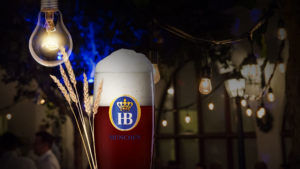
But even Hofbrauhaus Las Vegas has a dark side. Don’t worry, the forces are good with this one. We’re talking about our Dunkel Weizen brew, otherwise known as Dark Wheat beer.
For centuries, this beer has boasted an incomparable flavor profile that has pleased even the most discerning of beer lovers. Its rich brunette hue makes it beautiful on the outside, but it is what’s on the inside that really counts. This unique brew is made from a variety of special malts including Munich malt, Caramel, and Roestmalz. One sip is all it takes to recognize that this is unlike any beer you have ever had, and you can get it at one of the best places to drink in Las Vegas. Then there’s the way it’s made.
This popular brew is fermented similarly to light beer (which starts at 68° Fahrenheit and rises to 73.4°), but then it is stored at 37.4° for about one week —upside down!
See, we told you it was special. Due to the natural sedimentation, the yeast settles on the bottom of the keg. In order to redistribute the yeast, the keg remains upside down until just before tapping time. The beer is then bottled unfiltered and natural for quality and freshness you won’t find anywhere else. But don’t just take our word for it, get in here and try a stein of this seasonal favorite yourself!
Dark Wheat is only available two times a year: early January and June. If you are planning a trip to Las Vegas any time soon, we suggest you keep those dates in mind! Click here to try our food & beer!
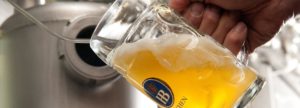
From the umbel to the glass
It is a long process until a fresh Hofbrau beer bubbles in the bottle or flows from the tap into the glass. Hofbrau Munich has been working according to the German purity law for more than four hundred years! As stipulated by the German purity law, only hops, malt, yeast, and water are used to begin the brewing process. The unique consumer protection law of 1516 is not only a benchmark but also a seal of approval for the quality of the beers. In addition, when purchasing, care is taken to process raw materials in the best and controlled quality.

Water – the valuable liquid
The brewing water for Hofbrau Munich is not ordinary groundwater but comes from its own deep well. Water pipes run around 150 meters below the brewery. There they have access to water supplies that were once left in the geological phase of the tertiary in the foothills of the Alps. Since before the stone age, this water has been preserved deep under the ground and is as fresh as on the first day.

Hops – the green gold
The hops that give the beers their characteristic aroma come from the Hallertau region. For the intense flavors, bitter hops varieties such as “Herkules” and “Magnum” are added to the flavor, while milder aroma hops such as “Hallertauer Perle” or “Select” refine the lighter beers. After the harvest in the late summer, the “green gold” of the Hallertau is dried. Then the stems and leaves are removed, as well as the “base components” of the unfertilized, female umbels. What remains is a slightly sticky, yellowish-green mass: the lupulin. It contains the bitter aromas typical of hops and can – compressed into so-called “pellets” – be stored for several years at up to 10 degrees Celsius without any loss of quality.
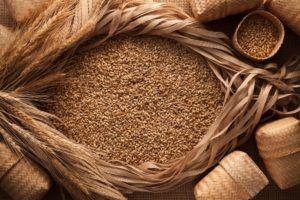
Malt – naturally matured
Around 6,000 tons of malt a year from eight different suppliers are processed for the Hofbrau beers. The different varieties used include light and dark barley malt, caramalt, and light and dark wheat malt for the wheat beers. Before one can speak of a real malt grain, barley and wheat grains have to be prepared for the brewing process. To do this, the maltster soaks the grain in water and it begins to germinate and grow. The maltster controls the natural ripening through the humidity, the temperature, and the ventilation. Then the grain is stored to dry. The hotter the drying process, the darker the malt and the stronger the color of the beer as a result.
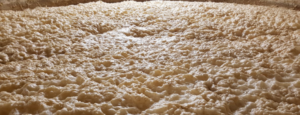
Yeast – consistently good taste
Glass for glass and bottle for bottle: In order for the fans of Hofbrau beer to experience the beer taste they love again and again and in consistently good quality, Hofbrau Munich relies on their own yeast cultivation system. Yeasts are unicellular organisms that are grown in strains and that reproduce themselves. Whether bottom-fermented or top-fermented – the yeast has a decisive influence on the taste of the beer. The bottom-fermenting yeast works for six to seven days at a cool 7 to 9 degrees Celsius. At the end of the brewing process, it settles on the bottom of the fermentation tank and can be removed from the brew. The top-fermenting yeast loves it warmer: at temperatures between 18 and 20 degrees Celsius it really gets going and works for four to five days. With the rising carbon dioxide, it drifts upwards and can be skimmed off.
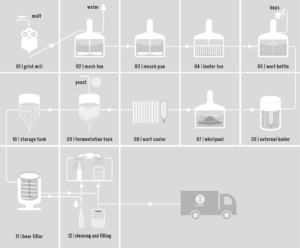
FROM THE GRIST MILL TO BOTTLING: IN TWELVE STEPS TO BEER
The graphic explains how the raw ingredients hops, malt, yeast, and water create a fine Hofbrau beer.
1. The malt grains are milled in a grist mill. They can then be processed further in the brewhouse.
2. The milled brewing malt is mixed with water in the mash tun (in the technical jargon: “mashing”) and heated. This dissolves the starch from the malt and breaks it down into fermentable sugars.
3. From the mash tun, so-called partial mashes are removed and cooked in a mash pan. In this process, the flour body components of the malt are physically digested. With the help of a pump, the partial mashes are returned to the mash tun. This intermediate step allows enzymes to better affect and break down starch.
4. In the lauter tun, the husks of the malt grain (husks) and other insoluble ingredients separate from the wort.
5. The hops is added. In the wort kettle, wort and hops are then cooked together.
6. In the external boiler, the wort of hops, malt and water are boiled for about an hour. This causes excess water to evaporate and certain volatile substances to be expelled. The process also sterilizes the wort, inactivates enzymes and allows the protein to clot (protein precipitation/flocculation).
7. The wort is set in rotation by a tangential inlet in the same vessel. Due to the rotational movement, the remaining protein coagulates in a compact cone with ‘hot break’ in the middle of the so-called whirlpool. After about 30 minutes of standing time, the so-called cast wort is removed in the direction of cooling. The hot break remains in the cooker.
8. In the wort cooler, the wort is cooled down to cellar temperature depending on the type of beer.
9. In the fermentation tank, the brewer’s yeast is added, and the fermentation process starts. During this, alcohol and carbon dioxide are produced from the fermentable sugars of the wort. The fermentation with bottom-fermenting yeast takes place at temperatures between 7 and 9 degrees Celsius and lasts roughly six to seven days. The yeast then settles at the bottom of the tank. Top-fermenting yeast ferments the wort in 4 to 5 days at 18 to 20 degrees Celsius and subsequently rises to the surface.
10. After completion of the main fermentation, the yeast is removed from the tank. The resulting “young beer” is stored until maturity at around 0 degrees Celsius for several weeks in the storage tank.
11. Using a beer filter, the bottom-fermented beer is filtered and placed in pressure tanks until filling.
12. The finished beer is filled in barrels or bottles. Barrels are first cleaned outside and inside. After filling the beer barrels are stored on pallets. Beer bottles are, of course, also cleaned and checked. After bottling, they receive a closure, are labeled, and then packaged. Ready for transport, our beer is now ready to be enjoyed all over the world!
Now you understand why you will get the best beer in Las Vegas at our Haus! Are you ready to taste some golden liquid, imported from the Hofbrau Brewery in Munich, Germany? We assume the answer is YES, so please click here to reserve your spot. Prost!
